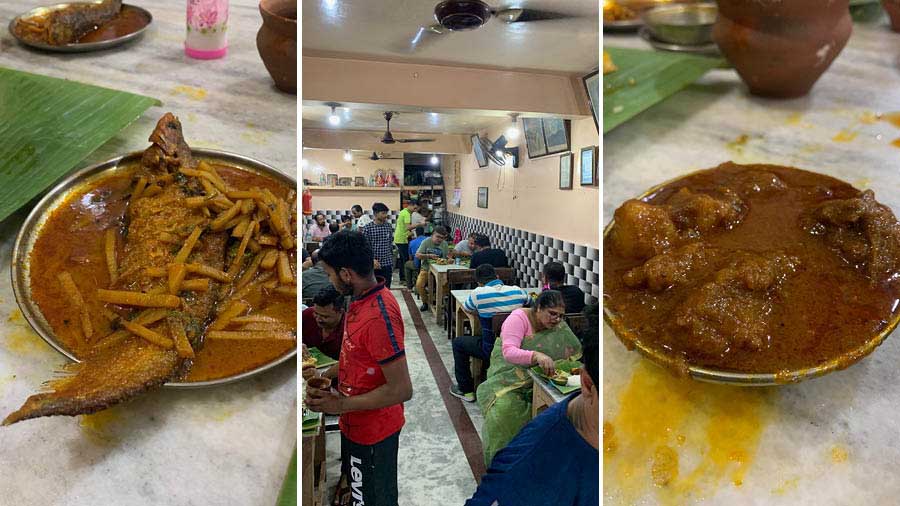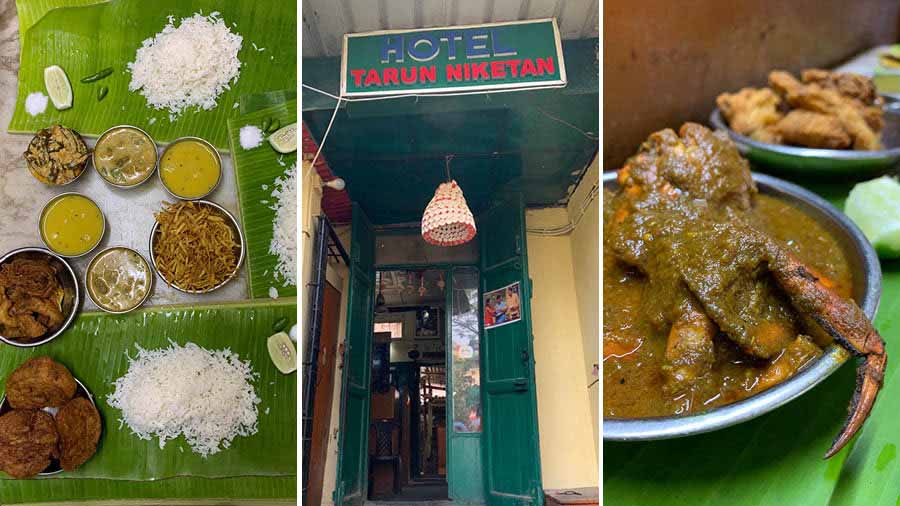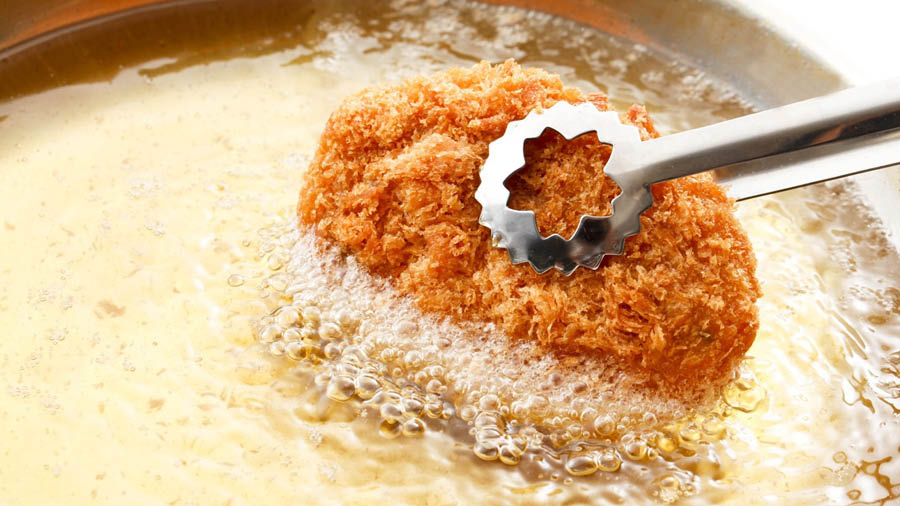When it comes to the city’s pice hotels, if Tarun Niketan is the Queen of South Calcutta, then Swadin Bharat Hindu Hotel is undoubtedly the King in the North. Tucked away at the end of a tiny by-lane off College Street, the eatery has quite a fabled, over-a-century-old history. It, too, dishes out some of the greatest hits from the Bengali kitchen.
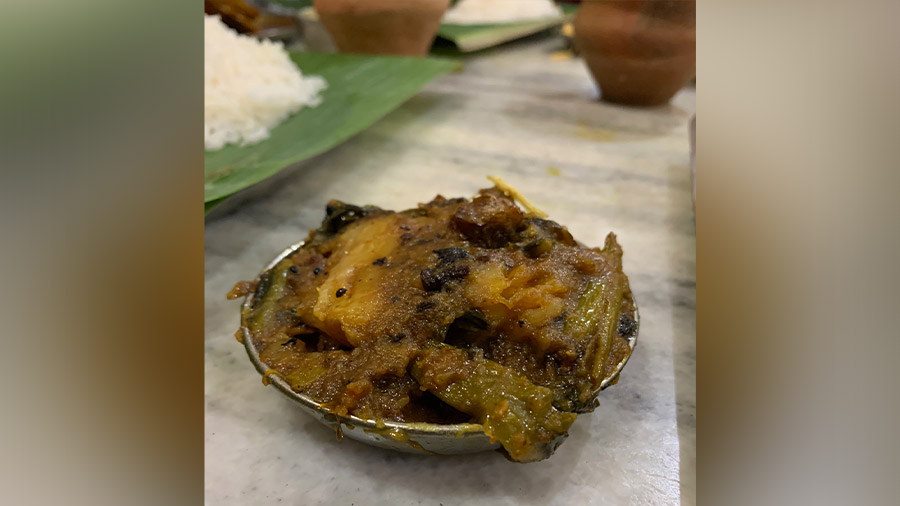
Netaji’s favourite Pui Shaaker Chorchori
But what makes the eatery even more iconic is that it was Netaji’s favourite lunch stop in the city during his college days at Presidency and then years later as mayor of the city. And while present-day diners (mostly students and professionals from the para) might or might not share the same appetite for revolutionary fervour, they definitely do keep coming back for his beloved Pui Shaaker Chorchori.
I, too, recently had a craving, so decided to make the trek across the city for my fill. But this time I also had another objective. During a recent meeting with Roni Mozumdar of Unapologetic Foods, NYC, he had asked me where I like to get my fill of mangsho, especially Kosha Mangsho. Industry instinct initially led me to the heavyweights — Anadi, 6 Bally-G, Kasturi or Golbari. But my heart really went back to Swadhin. It’s what I gave as my final answer that day. So, I wanted to go back and see if my heart and belly were right.
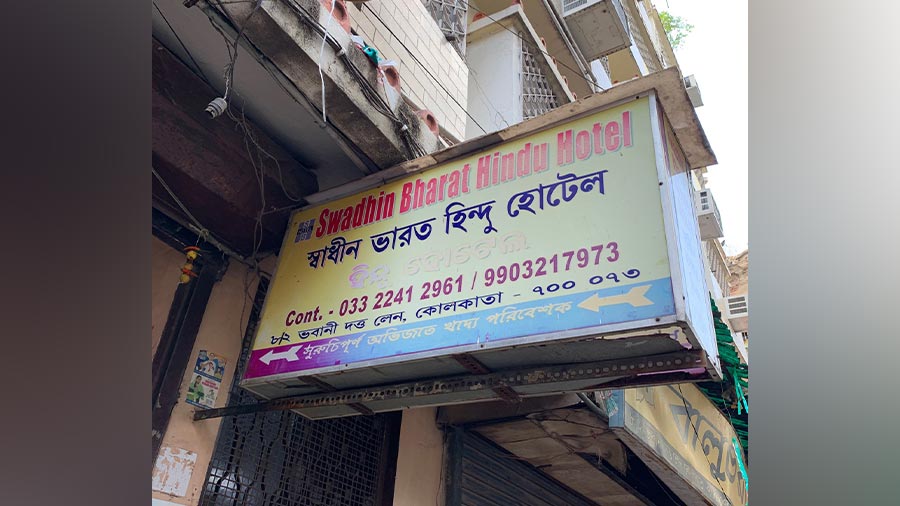
Swadhin Bharat Hindu Hotel
Now, my first piece of advice when heading there is, never drive. It’s bad enough there’s never any parking. And quite often that’s compounded by dharnas and demonstrations, as was the case on the Monday I chose to drop by. The second thing and this is more a suggestion to out-of-towners and south Calcuttans (probably the same thing in this case) — don’t try and make this the last stop on a north Calcutta food hop that also includes Paramount, Putiram and the rest, as there’s a good likelihood you’re going to be as uncomfortable as a beached whale by the end of this extremely doomed venture. There is after all a lot on this menu that deserves its own time and attention. Then there’s the layout of the hotel, it’s a smallish hall with two rows of four-seaters. And if you’re going in groups of twos or threes, always expect to share a table. Lastly, if you’re going there past 1pm, always expect to wait and whether it’s a short or long one only the Food Gods can tell. SOPs dealt with, let’s consider the ranna now.
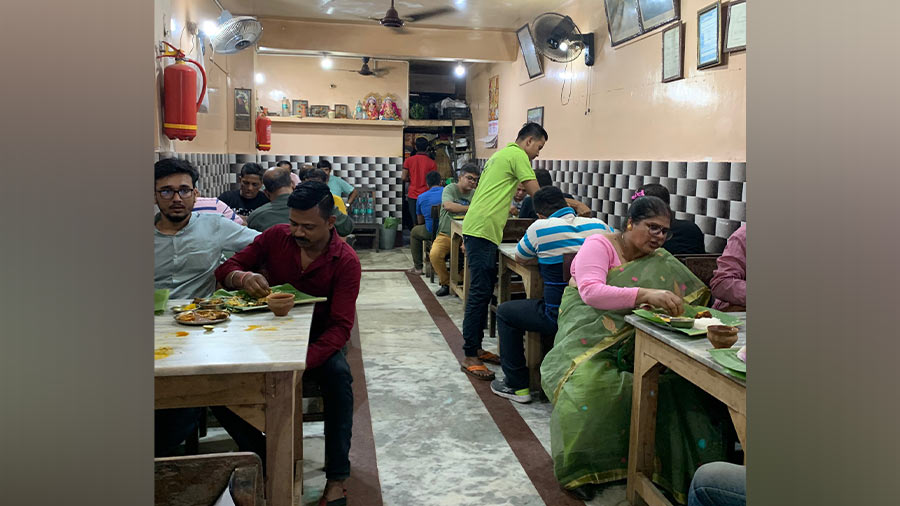
Scene inside the pice hotel
On this visit, thankfully for my fellow diner Dipto and I, we barely had a wait. Dipto’s a young and talented chef from the Sienna kitchen. His latest obsessions deal primarily with fermentation and mixology, but he’s also one of our best cooks and butchers, especially when it comes to maachh. Besides an objective inspection of the mangsho, I also wanted to see what he felt about the many maachh preparations at Swadhin and how they could influence some of our baajar tables.
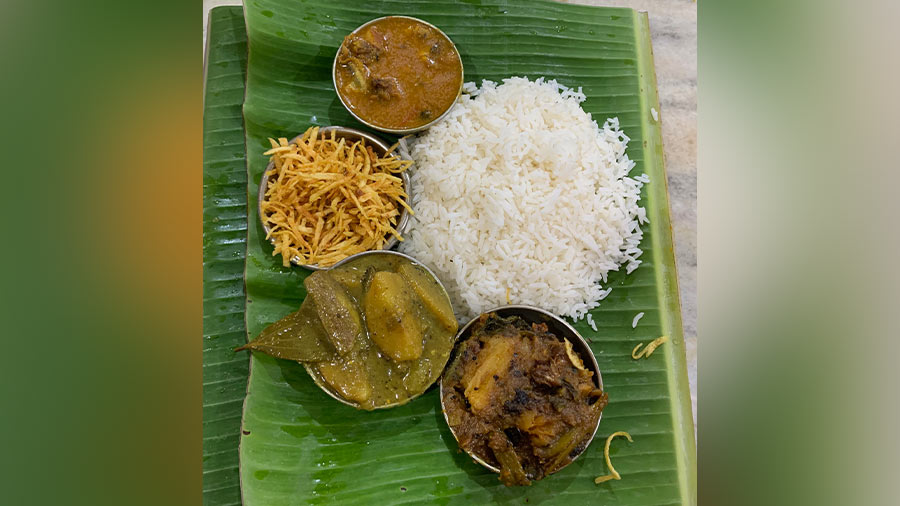
The lunch menu with special Aloo Bhaja
Since we reached a little late, a lot of the torkaris and bhaajas were already over, but thankfully the famed chorchori wasn’t. Along with it we also asked for some aloo bhaja, muro diye dal and shukto. Now, one of the things I admire about the Swadhin shukto is that it dares to be punchy and radhuni forward as opposed to the more biyebari style that’s creamier, more about the posto. It playfully walks that line of bitter and astringency, reminding, almost daring, you to enjoy it. And, that’s the thing, even though you know you’re eating what was probably that one most dreaded and hated dish, the sight of which made most Bengali children almost instantaneously produce a shrieking wail of CHAI NA! — you just can’t help but keep going back for one more bite of this shukto. Talk about teto whet-ing the appetite! The aloo bhaaja was just the right amount of jhurjhure meets crispy, and the dal was deliciously halka, yet meaty (probably because they use rui and not katla). And then there was the chorchori, and I get what all the fuss is about.
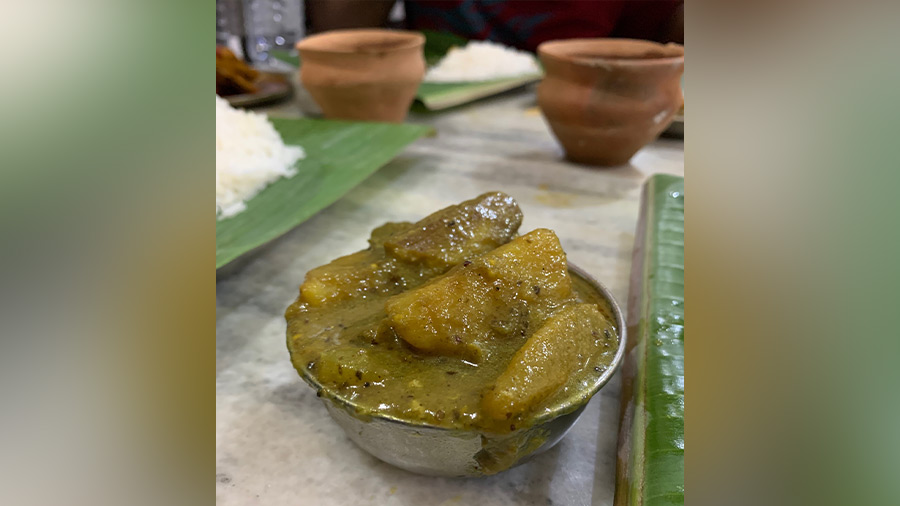
The Shukto is to die for
Now, conventionally, the hallmark of a great chorchori is that the hand behind the prep is always mindful of the cooking time and done-ness of each vegetable in the mix. In the case of Swadhin’s chorchori, it’s almost like they cook the vegetables like kosha versus gently stirring the pot, a very contrarian move if you wanted to be mindful about representing each vegetable. But, in turn, when you reject that principle, what you get is this amazing dimension of caramelisation on the vegetables, thus making it less a harmonious symphony of flavours and more a robust and extremely confident solo from one of the great tenors. No wonder it was our bravest and boldest leader’s favourite!

Aloo-Begun diye Pabda Maachh
For the maachh progression, we had requested a trio of mourola, parshe and begun diye pabda and at first glance we were a little underwhelmed when they arrived. Somehow, when our server enthusiastically pitched all three to us, he’d made it seem like all three were made in very different styles of jhol. But to the eye they were rather similar — less tel jhol, more laal and jhaal with lots of perfectly jardinière-d alu thrown in for good measure. And the two tiniest morsels of begun in the pabda. Admiration for the insane boti skills on the aloo aside, I was terrified that probashi me had been duped. That’s when Dipto burst out, while wolfing down a big chunk of parshe — chef, the cook on this maachh is insane. And, I think, that’s the wisdom that I took away from each maachh preparation that day.

The flavour on the Mourola had this perfectly oily and mineral backbone
Even though the jhol on all three maachh were similar, since none of the maachh had been fried to a crispy kora bhaaja, they retained a lot of their unique flavours and textures. If you can get just the right cook on any kind of chhoto maachh, clearly the jhol will always express those true flavours in essence. Thus the flavour on the mourola had this perfectly oily and mineral backbone. The parshe was rich, fatty, and with just the right hint of gamey. And then there was the fact that the pabda flaked, rather melted, right off the bone like butter.
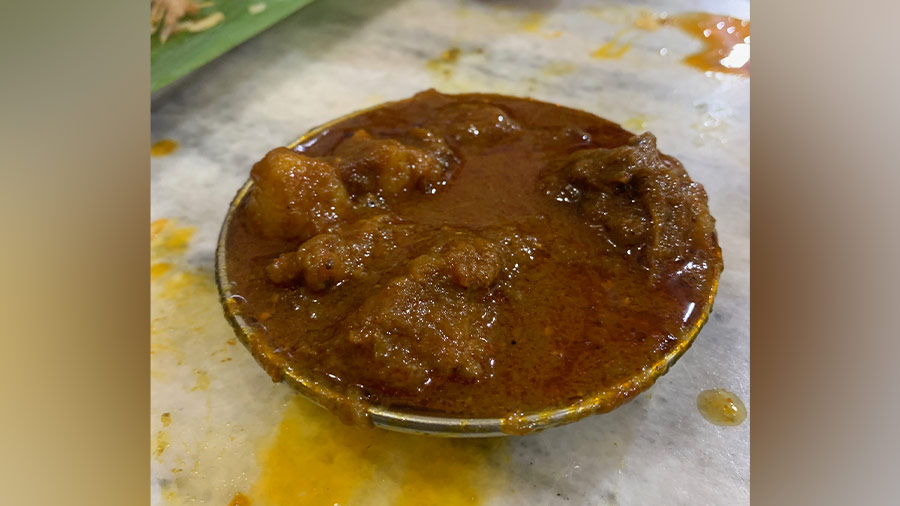
Kosha-style Mangsho is the best one can get
Sensing that we’d gotten over our initial dismay and hesitation, our server tried very hard to pitch us some very good-looking ilish and chingri from the next table, but we got a feeling it might have been a bit too maachh. And so we moved on to the final act — their kosha-style mangsho. One look at the bati and I knew that my heart and belly could not be wrong. It had that perfect gleaming level of rendered chorbi (fat) on top. The base was just that right colour of deep reddish-brown. Also, considering it was prepared at a bhaater (rice) hotel, and not a cabin, there was just that little bit more jhol vs makha-makha glaze going. And, man, was the mangsho tultule-tender as can be, a quality that one can definitely attribute to the fact that Swadhin uses kochi patha and not riyazi mutton (much better for rezala and biryani). All in all, so good that I broke my own rule and got a third helping of bhaat to mop up all the jhol on my kola pata (banana leaf).
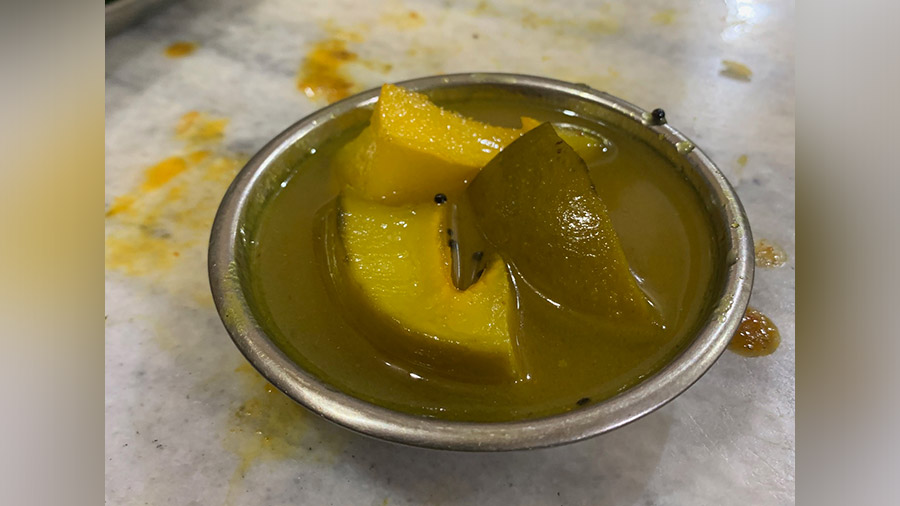
The green mango chutney
I even refused to refresh and cleanse my palate with the aamer (mango) chutney that Dipto wiped clean. That mangsho had to be the last thing I tasted that afternoon. Furthermore, and most importantly, it was definitely worthy of being my last word on that subject to Roni.
A copywriter by training, a Delhi-ite at heart and a probashi Bengali by blood, Auroni Mookerjee used to make ads for a living. A few years ago, he gave up his copywriter’s job to cook and feed people full-time, and moved to the deliciously joyous city of Kolkata. Now, he is executive chef and head of the kitchen family at the Sienna Store & Cafe.


